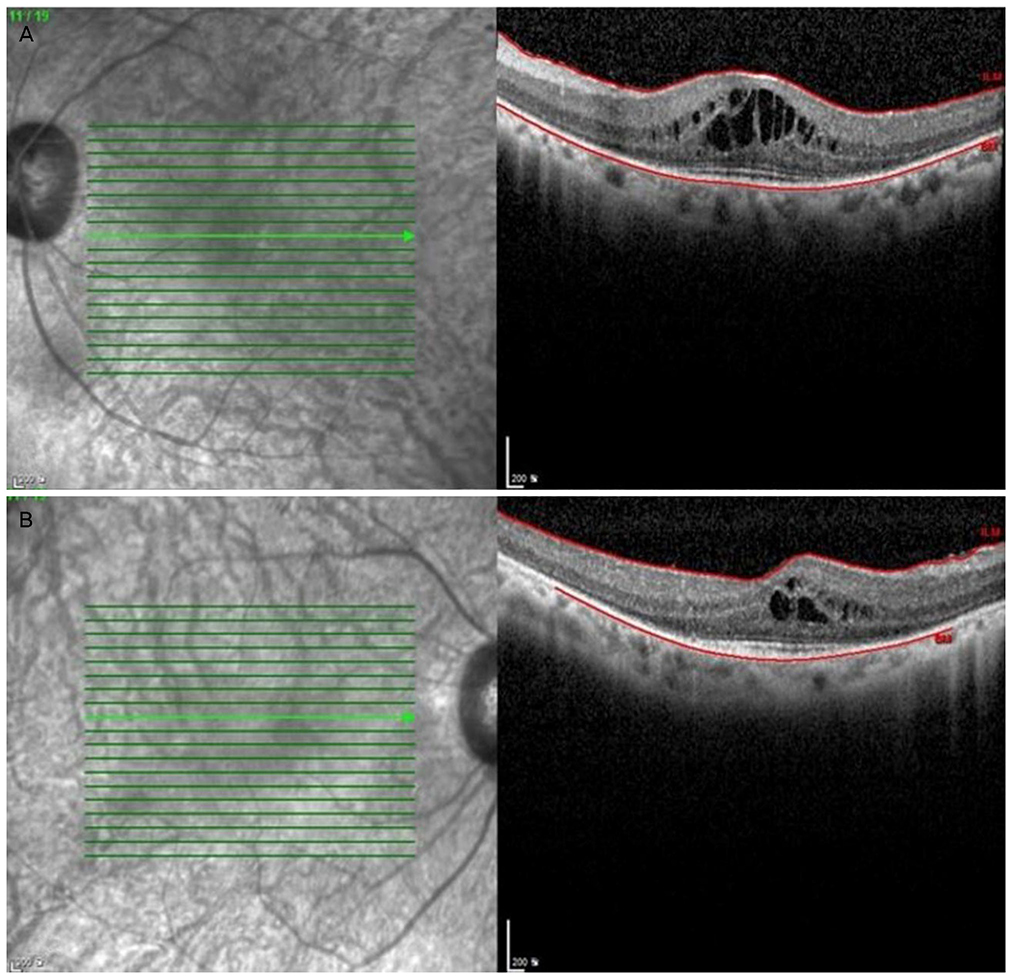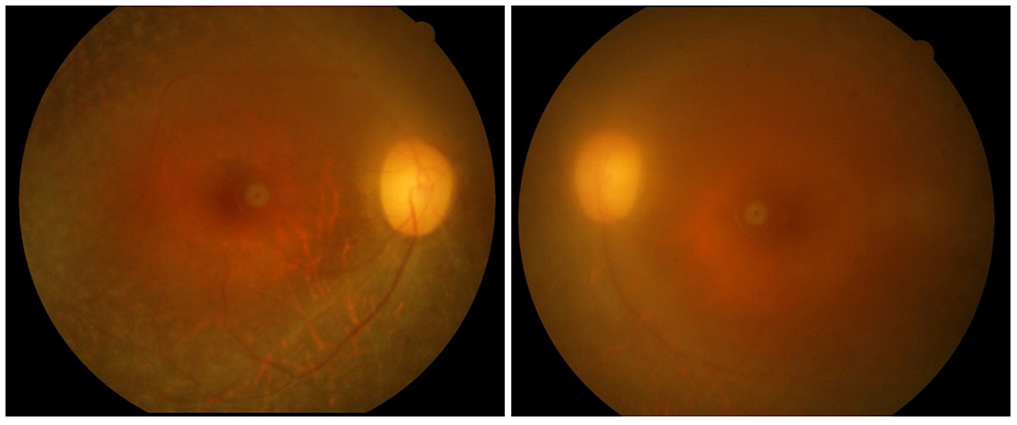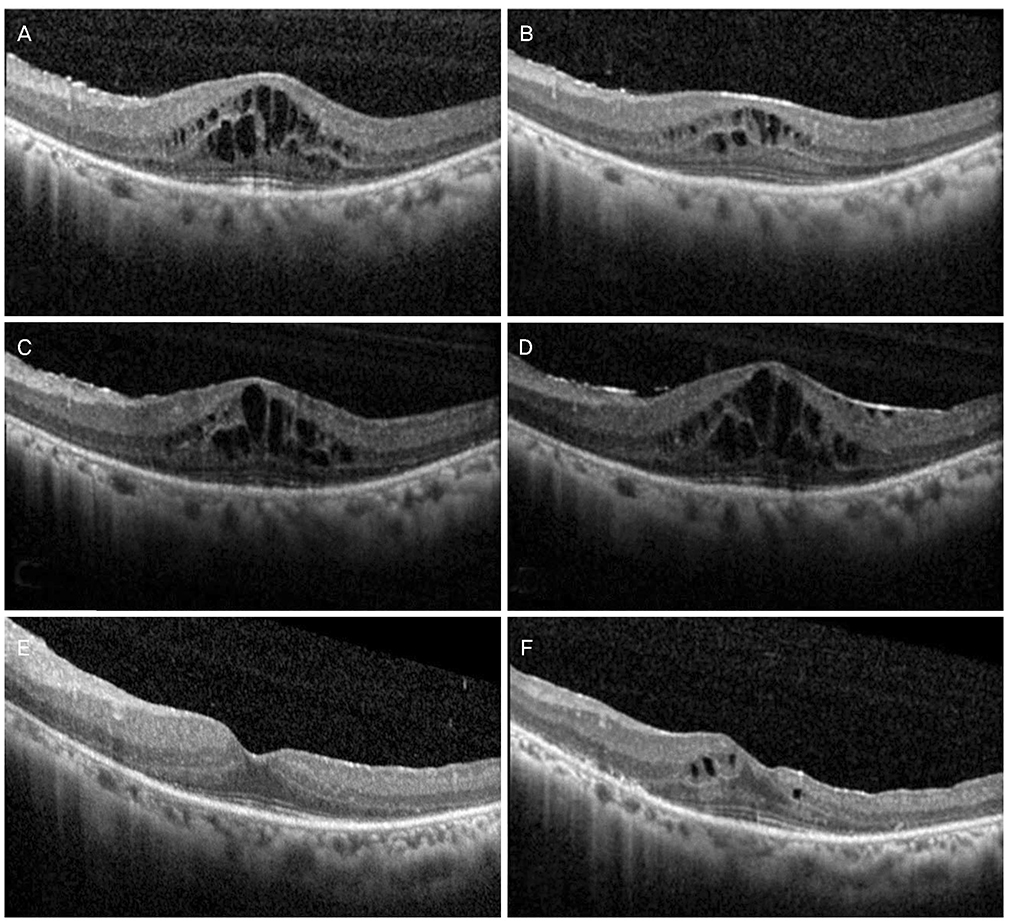J Korean Ophthalmol Soc.
2018 Aug;59(8):790-796. 10.3341/jkos.2018.59.8.790.
Pars Plana Vitrectomy for Cystoid Macular Edema in a Retinitis Pigmentosa Patient
- Affiliations
-
- 1Department of Ophthalmology, Gyeongsang National University College of Medicine, Jinju, Korea. in0chung@hanmail.net
- 2Department of Ophthalmology, Gyeongsang National University Changwon Hospital, Changwon, Korea.
- 3Gyeongsang Institute of Health Sciences, Gyeongsang National University, Jinju, Korea.
- KMID: 2418508
- DOI: http://doi.org/10.3341/jkos.2018.59.8.790
Abstract
- PURPOSE
To report the first case of cystoid macular edema in a retinitis pigmentosa patient with pars plana vitrectomy.
CASE SUMMARY
A 43-year-old female visited our hospital with visual disturbances of both eyes. Corrected visual acuity was 20/22 in the right eye and 20/25 in the left eye. Peripheral depigmentation and atrophy of the retinal pigment epithelium, pigmentary retinal degeneration, and attenuated arterioles were observed in both eyes. Cystoid macular edema was observed on optical coherence tomography which showed that the central macular thickness was 308 µm in the right eye and 422 µm in left eye. Intravitreal aflibercept was injected into the left eye. One month after injection, the central macular thickness showed no response with a thickness of 449 µm. An intravitreal dexamethasone implant was then injected, 1 month after injection, the central macular thickness was 367 µm. Six months after injection, the patient again complained of visual disturbance of the left eye with a corrected visual acuity of 20/70. Vitreous opacity was observed and the central macular thickness was 501 µm. The patient underwent pars plana vitrectomy. Three days after surgery, the central macular thickness was 320 µm. One year after surgery, the corrected visual acuity was 20/33 and the central macular thickness was 311 µm.
CONCLUSIONS
Pars plana vitrectomy due to cystoid macular edema in a retinitis pigmentosa patient has not been previously reported in the Republic of Korea. Pars plana vitrectomy can therefore be an effective treatment for cystoid macular edema in retinitis pigmentosa patients.
Keyword
MeSH Terms
Figure
Reference
-
1. Musarella MA, Macdonald IM. Current concepts in the treatment of retinitis pigmentosa. J Ophthalmol. 2011; 2011:753547.
Article2. Huang Q, Chen R, Lin X, Xiang Z. Efficacy of carbonic anhydrase inhibitors in management of cystoid macular edema in retinitis pigmentosa: a meta-analysis. PLoS One. 2017; 12:e0186180.
Article3. Mrejen S, Audo I, Bonnel , Sahel JA. Retinitis pigmentosa and other dystrophies. Dev Ophthalmol. 2017; 58:191–201.
Article4. Heckenlively JR, Jordan BL, Aptsiauri N. Association of anti-retinal antibodies and cystoid macular edema in patients with retinitis pigmentosa. Am J Ophthalmol. 1999; 127:565–573.
Article5. Strong S, Liew G, Michaelides M. Retinitis pigmentosa-associated cystoid macular oedema: pathogenesis and avenues of intervention. Br J Ophthalmol. 2017; 101:31–37.
Article6. Vinores SA, Küchle M, Derevjanik NL, et al. Blood-retinal barrier breakdown in retinitis pigmentosa: light and electron microscopic immunolocalization. Histol Histopathol. 1995; 10:913–923.7. Ahn SJ, Kim KE, Woo SJ, Park KH. The effect of an intravitreal dexamethasone implant for cystoid macular edema in retinitis pigmentosa: a case report and literature review. Ophthalmic Surg Lasers Imaging Retina. 2014; 45:160–164.
Article8. Sudhalkar A, Kodjikian L, Borse N. Intravitreal dexamethasone implant for recalcitrant cystoid macular edema secondary to retinitis pigmentosa: a pilot study. Graefes Arch Clin Exp Ophthalmol. 2017; 255:1369–1374.
Article9. Shah CR, Brent MH. Treatment of retinitis pigmentosa-related cystoid macular edema with intravitreous ranibizumab. Retin Cases Brief Rep. 2010; 4:291–293.
Article10. Yuzbasioglu E, Artunay O, Rasier R, et al. Intravitreal bevacizumab (Avastin) injection in retinitis pigmentosa. Curr Eye Res. 2009; 34:231–237.
Article11. García-Arumí J, Martinez V, Sararols L, Corcostegui B. Vitreoretinal surgery for cystoid macular edema associated with retinitis pigmentosa. Ophthalmology. 2003; 110:1164–1169.
Article
- Full Text Links
- Actions
-
Cited
- CITED
-
- Close
- Share
- Similar articles
-
- Pars Plana Vitrectomy for Vitreous Hemorrhage in Coats-Type Retinitis Pigmentosa
- Pars Plana Vitrectomy in Pars Planitis and Posterior Uveitis
- Pars Plana Vitrectomy in Pars Planitis and Posterior Uveitis
- The Efficiency of Vitrectomy for Diabetic Macular Edema
- Intravitreal Injection of Triamcinolone Acetonide on Refractory Uveitis






